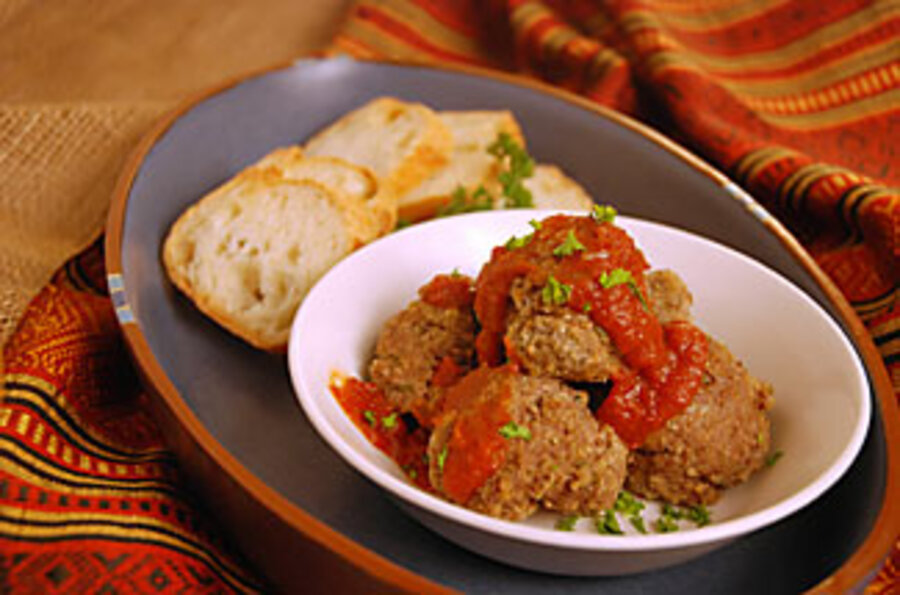A preference for local meat
Loading...
When it comes to vegetables, even urban "locavores" can get their hands dirty in the effort to eat only local foods. All you need is a bit of sun and a patch of soil, and by summer's end you can decorate salads with your own "locally grown" produce.
Meat, on the other hand, is another challenge completely. That's best left to farmers and ranchers.
Local meat – livestock consumed within 150 miles of the place where it was humanely raised – is still a relatively small industry. However, more farmers' markets, mail-order companies, and stores that specialize in organic or local foods are featuring local meats. (To find a store near you, visit www.localharvest.org.) Proponents are quick to point to the benefits: Local meats aren't exposed to the same stresses commonly found in feedlots, and there is a noticeable difference in taste, too.
"Grass-fed meat tends to be leaner overall, but I would contend far more flavorful," says Kurt Friese, a chef from Iowa City, Iowa, whose restaurant, Devotay, serves mainly local produce, including meat from area farms. "For beef to taste like beef, cows need to eat what they are built to eat."
Cows aren't designed to digest corn, a primary sustenance used in feed lots. As a result, most beef tastes sweet, like corn, and contains more fat.
Along with grass-fed beef and chestnut-fed pork, Devotay also offers bison, or buffalo, on its menu.
"Bison is so fantastic I often say it tastes more like beef than beef does," says Mr. Friese who shares his recipe for Devotay Albondigas (bison meatball tapas) in his new cookbook, "A Cook's Journey: Slow Food in the Heartland" (see recipe). Devotay buys its bison meat from a farm in nearby Solon, Iowa. There the bison roam in grass-filled paddocks on 110 acres.
Grass-fed cattle, however, do take longer to reach market weight and the yields aren't as high, so it is more expensive than meat produced on feedlots, says Friese. But food-industry critics – from Barbara Kingsolver to Michael Pollan – say the average American's diet would improve with less emphasis on meat. Even Friese, whose restaurant sits smack in the middle of steak-house country, contends it isn't hard to satisfy customers with a less-is-more approach.
"We don't offer enormous cuts of prime rib," says Friese. "Our cuts are simpler, and we offer a wide range of vegetarian options."
Friese finds local meats are a good option for those who still like to eat meat but are mindful of their consumer choices. "There is a wide range of ways of improving our food system," he says. "Some people choose not to eat meat, I choose to not eat [imported] bananas."
Sounds like a fair trade-off.
Bison Albondigas
Kurt Friese's Devotay restaurant in Iowa City is primarily a tapas bar. Since 1996, one item that has never left the seasonally changing menu is albondigas, or meatballs. Devotay uses local bison meat from Bill Leefer's ranch near Solon, Iowa, for this popular dish. This recipe serves a crowd, but it can be halved or quartered (quartered recipe serves 4).
1 onion, minced
2 tablespoons garlic, chopped
2 tablespoons olive oil
2 tablespoons salt
1/4 cup herbs, chopped (consider equal parts parsley, thyme, oregano, basil, and rosemary)
1/2 cup cooking sherry
4 pounds ground bison
6 eggs
3 tablespoons Worcestershire sauce
Enough bread crumbs for desired consistency
Preheat oven to 375 degrees F.
Sauté the onion and garlic in olive oil until tender with salt, herbs, and garlic. Deglaze by adding sherry, then reduce liquid 50 percent by simmering, and cool.
Mix the bison with eggs and Worcestershire sauce, then add cooked, cooled onion mixture and bread crumbs until proper consistency is reached. To test the consistency, portion with a sorbet-size scoop, and form the meat mixture into balls a little smaller than golf balls. If they hold up well, you have the right consistency.
Flatten a small amount into a patty and fry it quickly on the stove top, then adjust the mixture's seasoning to taste.
Form the rest into balls and place on a parchment-lined cookie sheet. Bake about 15 minutes or until firm. Serve plain or with your favorite tomato-sauce recipe.
– Adapted from 'A Cook's Journey: Slow Food in the Heartland,' by Chef Kurt Michael Friese.






